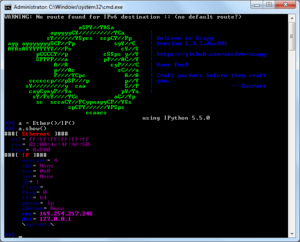Scapy
 | |
 | |
| Developer | Philippe Biondi, Guillaume Valadon, Pierre Lalet |
|---|---|
| Stable release |
2.4.0
/ 27 March 2018 |
| Preview release | |
| Implementation language | Python 2 and Python 3 |
| OS | Cross-platform |
| License | Free software (GPLv2+) |
| Website |
www |
Scapy is a packet manipulation tool for computer networks,[1][2] written in Python by Philippe Biondi. It can forge or decode packets, send them on the wire, capture them, and match requests and replies. It can also handle tasks like scanning, tracerouting, probing, unit tests, attacks, and network discovery.
Scapy provides a Python interface into libpcap, (WinPCap/Npcap on Windows), in a similar way to that in which Wireshark provides a view and capture GUI. It can interface with a number of other programs to provide visualisation including Wireshark for decoding packets, GnuPlot for providing graphs, graphviz or VPython for visualisation, etc.
Scapy supports Python version 3 since 2018 (scapy 2.4.0+).
Kamene (http://github.com/phaethon/kamene) is an independent fork of scapy. Initially, it was created with a purpose to add python3 support to scapy and was named scapy3k. Since 2018, it is renamed to kamene and continues independent development.
References
- ↑ Gift, Noah; Jones, Jeremy M. (2008). Python for Unix and Linux System Administration. O'Reilly Media. pp. 173–176. ISBN 978-0-596-51582-9.
- ↑ Dwivedi, Himanshu; Clark, Chris; Thiel, David (2010). Mobile Application Security. McGraw-Hill. p. 384. ISBN 978-0-07-163356-7.
External links